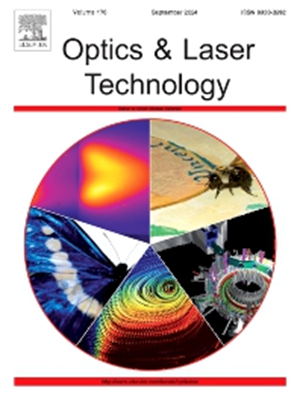Online monitoring of surface forming quality in laser-arc hybrid butt welding with uneven joint gaps based on arc signal diagnosis
IF 4.6
2区 物理与天体物理
Q1 OPTICS
引用次数: 0
Abstract
High-power laser-arc hybrid welding is commonly employed in the welding of medium-thickness steel. In full-penetration butt welding, butt joint gaps are particularly prevalent, especially as plate thickness increases, which in turn tend to exacerbate underfill and surface collapse defects. Consequently, it is essential to monitor the surface collapse defects during the welding process for medium-thickness steel. In this paper, a novel method is proposed to monitor surface collapse defects for laser-arc hybrid welding of medium-thickness steel with uneven joint gaps based on voltage signal diagnosis and machine learning. Firstly, the interrelation mechanism between the butt joint gap, surface collapse, and the voltage signal is analyzed with high-speed images, which is adopted to guide the time/frequency feature extraction in the proposed method. Then, it is found that the changes in peak and base voltages, along with the instantaneous frequency of arc pulse captured through variational mode decomposition (VMD), reflect the surface collapse defect, significantly affected by the butt gap. On this basis, a back propagation neural network (BPNN) is constructed to identify the extracted features, realizing the monitoring of the surface collapse defects with a precision of 94.24%.
求助全文
约1分钟内获得全文
求助全文
来源期刊
CiteScore
8.50
自引率
10.00%
发文量
1060
审稿时长
3.4 months
期刊介绍:
Optics & Laser Technology aims to provide a vehicle for the publication of a broad range of high quality research and review papers in those fields of scientific and engineering research appertaining to the development and application of the technology of optics and lasers. Papers describing original work in these areas are submitted to rigorous refereeing prior to acceptance for publication.
The scope of Optics & Laser Technology encompasses, but is not restricted to, the following areas:
•development in all types of lasers
•developments in optoelectronic devices and photonics
•developments in new photonics and optical concepts
•developments in conventional optics, optical instruments and components
•techniques of optical metrology, including interferometry and optical fibre sensors
•LIDAR and other non-contact optical measurement techniques, including optical methods in heat and fluid flow
•applications of lasers to materials processing, optical NDT display (including holography) and optical communication
•research and development in the field of laser safety including studies of hazards resulting from the applications of lasers (laser safety, hazards of laser fume)
•developments in optical computing and optical information processing
•developments in new optical materials
•developments in new optical characterization methods and techniques
•developments in quantum optics
•developments in light assisted micro and nanofabrication methods and techniques
•developments in nanophotonics and biophotonics
•developments in imaging processing and systems

 求助内容:
求助内容: 应助结果提醒方式:
应助结果提醒方式:


